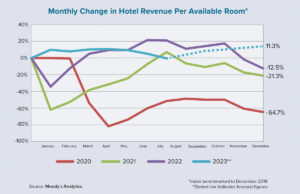It looked like the multifamily-housing sector might see a decline and a slow recovery when COVID-19 struck in March 2020. But it hasn’t turned out that way. By this past June, asking rents were breaking records once again in many U.S. cities. On a national basis, rents rose by 6.3% year over year in June, according to Yardi Matrix. In real dollars, this was an increase of $23 from the prior month to a record-breaking average of $1,482. It also was the largest nationwide increase in the history of Yardi’s dataset.
In several cities in the Southwest and Southeast regions — where lots of people are moving — these rent-price gains mirrored the extraordinary price increases for owner-occupied homes. For example, rents in Phoenix rose by 17% annually in June. The gains were similarly impressive in Tampa and California’s Inland Empire (each up by 15.1%), Las Vegas (up 14.6%) and Atlanta (up 13.3%), Yardi reported.
As for what lies ahead in the short term, Yardi predicted that annualized rent increases would continue to accelerate over the summer (when rents typically rise fastest) before tapering off to more normal levels in the 3% range by year’s end. Again, this predicted “cooling-off” trend echoes the forecast for owner-occupied housing.
The multifamily sector is expected to emerge from COVID-19 similarly positioned for long-term stability as it was pre-pandemic. Buoyed by strong demographic trends, analysts say there will be ample demand from potential renters for a limited supply of apartments in many cities.
“Rents are really rising across the board based on our data,” says Chris Nebenzahl, editorial director at Yardi Matrix. This is true for all asset types. Prior to the pandemic, several markets, such as Washington, D.C., were overbuilt in regard to luxury apartments. This forced some landlords to offer up perks such as free rent for a few months. For the most part, Nebenzahl says, these concessions have dried up for prospective tenants.
“The luxury segment might actually outperform the workforce-housing segment a little bit again because people are awash with capital,” Nebenzahl says. “At least, right now, they’ve got cash.”
This is not to say there aren’t pain points for the apartment sector. The multifamily markets in some high-priced cities with heavily tech-based economies, such as San Francisco and San Jose, have seen rents fall on a year-over-year basis. In this regard, migration trends are playing a role. Many workers who have the freedom to work from home have moved out of high-priced cities, putting pressure on rents there.
“New York is recovering a little bit quicker,” Nebenzahl says. “The big tech firms like Google and Salesforce and so forth have not required employees to be back in the office. So, what did they do? They’re spending time with parents, with friends, in other markets and vacation homes, wherever it may be.”
Also, the full story of COVID-19 has yet to play out. Many unemployed renters racked up significant debt during the recession and owe back rent — leaving question marks for the stability of certain assets. Nebenzahl says it appears that most renters have been able to weather the health crisis and will emerge just fine due to an improving economy.
When you look at the United States and you look at all the different dynamics that exist, there’s one common theme and that’s that everybody needs a place to live.
Justin Parker,
Chief financial officer, RCN Capital
“There was a lot of unemployment benefits that were paid out,” he says. “So, while we certainly went through a cataclysmic economic event, there was a lot of cash floating around — and continues to float around — for people to afford to pay the rent and even to afford higher rents.”
At the midpoint of 2021, the bottom line is that the multifamily sector was arguably once again the most desirable and easily financed asset type. Lenders are aggressively competing for multifamily loans.
“From a high level, we are extremely bullish on multifamily,” says Justin Parker, chief financial officer for RCN Capital. “We’ve put a lot of efforts into revising our guidelines to be a little bit more aggressive toward the product. When you look at the United States and you look at all the different dynamics that exist, there’s one common theme and that’s that everybody needs a place to live.”
But Parker also says that his company is not ignoring the pandemic’s impact on certain renters and assets. It looks at the tenant mix, including a verification of any tenants that have rent-deferral plans, but Parker says that RCN doesn’t prefer one class of apartments over another.
“We want to make sure that the property is cash flowing, and there’s a successful project and business model in place for that property,” he says, noting that the borrower’s experience level also matters.
“We want to make sure that the sponsor or property manager has the capability to handle whatever property type they’re up against,” Parker says. ●





